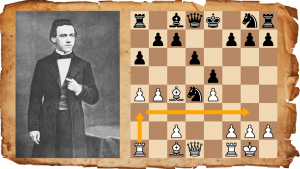
Is 'King Of The Hill' Safe?
In the "King of the Hill" chess variant, the goal of the game is to get your king to the fourth rank in the center as quickly as possible. But have you ever seen a white king on g3 after just eight moves in normal chess? Well, that's exactly what happened during the World Junior Championship in 1990, which was played in Singapore.
In the U18 section, in the game between Mohamad Taha and Sergei Tiviakov (who was was already a very strong player at the time), the following position occurred after a curious novelty by White on move six in what started out as a perfectly normal Nimzo-Indian Defense:
1.d4 Nf6 2.c4 e6 3.Nc3 Bb4 4.Qc2 c5 5.dxc5 Bxc5 6.Bg5!?N Bxf2+ 7.Kxf2 Ng4+ 8.Kg3
One imagines that the youthful Tiviakov thought he must have been completely winning already: White fell for the simplest of opening traps on move six, and now his bare and unprotected king has already been driven out in the open; Black will immediately regain his piece by taking on g5, and then a deadly discovered check with the knight is already threatened.
Indeed, Tiviakov played 8...Qxg5 and now surely it was time to resign? Well, things turned out to be not quite so clear after 9.Nf3 Qh5 10.Nb5!?, after which it became clear White had some threats of his own, notably Nc7+ and Nd6+. In fact, the game ended in a draw just seven moves later!
Perhaps some readers know the American folk song, famously performed by Ry Cooder and by Bruce Springsteen, called How Can a Poor Man Stand Such Times and Live? Well, that's what any chess player wants to scream upon seeing the white king so naked and exposed out in the open field so shortly after the start of the game. Yes, in some openings (such as the King's Gambit) the king sometimes chooses an early sortie, but to g3?! Surely not.
Well, believe it or not, there's a long tradition of early king marches to the g3 square in chess! Mind you, I'm not talking about situations where the king is driven or forced towards g3, such as in the above situation, or the following game, played by the second world champion:
Here's an even earlier game, quite well-known by the famous Russian master Alexander Petrov (1794-1868), who gave his name to the Petrov (or Petroff) Defense:
But as said, these are not the situation I have in mind and I don't really like them as examples, because White had "no choice" but to go all the way to g3 in these games. The white kings were hunted, and didn't move forward voluntarily. Instead, the instances I have in mind are cases where White voluntarily moves his king up the board.
Take a look at the first moves of a game between two of the best players of the early 20th century, starting from the Four Knights' Defense:
1.e4 e5 2.Nf3 Nc6 3.Nc3 Nf6 4.Bb5 Nd4 5.Nxe5 Qe7 6.f4 Nxb5 7.Nxb5 d6 8.Nf3 Qxe4+
What do you think White played here? The normal move, of course, would be 9.Qe2, modestly trading queens, but in the endgame only Black can be better due to his pair of bishops and White's somewhat unfortunately placed pawn on f4. Therefore, Bogoljubov played the surprising 9.Kf2!? Ng4+ 10.Kg3!
Amazing, isn't it? But again, once you've looked at the actual position, it turns out that the king is really not all that unsafe on g3. The pawn on f4 and the knight on f3 do a decent job of protecting it—for now— and just like in the Taha-Tiviakov game we started with, White threatens to jump to c7 (and then a8) with his knight.
In addition to that, the threat of Re1, pinning the black queen, cannot be ignored. In the original game, Rubinstein played a king move himself now: 10...Kd8!?, which isn't bad, although Black later lost the game. A few years later, Rubinstein improved on this in his game against Rudolf Spielmann: 10...Qg6! Now, it seems all over, because where does White's king go? But Spielmann remained cool and played 11.Qe2+ Kd8 12.Re1!? inviting the discovered check!
A fantastic position! White's king is out in the open, but he's threatening mate-in-one and there's no immediately decisive check for Black! To be fair, Black was still better and after the cool 12...Bd7!, Rubinstein managed to win the game—the line hasn't been repeated often for White. However, it did prove once more that a naked white king on g3, while certainly risky, is not always fatal.
Now, if the king can often survive in open positions, it's reasonable to assume that in closed positions, it feels even safer on g3. And sure enough, this was realized hundreds of years ago by the strongest masters. Here's none other than the great Philidor demonstrating the concept for the first time in an odds game where White plays without a knight on b1 and Black without a pawn on f7:
The biggest pioneer for the idea that you can safely put your king on g3 in closed positions, was the Irish master Alexander McDonnell (1798-1835). McDonnell (his name is sometimes spelled as MacDonnell) was one of the leading players of his time before he died at an early age of a kidney disease. In 1834, just a year before he would pass away, he played a series of several matches against the strongest player of the time, Louis-Charles de Labourdonnais (1795-1840).
Now, a lot can be said (and has been said) about these fascinating matches, and perhaps I will weigh in someday as well. But right now, I want to focus on one specific variation that was played in this the match, namely the Sicilian/French hybrid, which typically arose after the following move sequence (McDonnell played the White pieces):
This position occurred, with some slight alterations, no fewer than seven times in the match, and McDonnell scored horribly with it. And let's be honest: to modern eyes, the sequence does look highly questionable. Why, for instance, did they play this strange move order to arrive in a French-type of position at all?
Well, firstly, it's important to understand that White's current main line, 2.Nf3 and 3.d4, was not yet considered to be critical. (After all, it does give up a central pawn right away.) A second aspect is explained by Raymond Keene in his book The Evolution of Chess Opening Theory (1985):
McDonnell clings to the notion, in line with the current opinion of his day, that White must maintain the pawn chain against the French or it meet it by (1.e4 e6 2.d4 d5) 3.exd5. Yet his French antagonist avoided the latter course, by transposing into the defence via 1...c5. They might all, perhaps, not have been so exasperated had they understood that after advancing his [king's pawn] to e5 White need not necessarily maintain his pawn chain, but can seek the opportunity for a judicious exchange, dxc5 and/or exf6.

In this light, White'a play starts to make a little bit more sense: he wants to maintain the pawn chain d4-e5 at all costs, even if this means moving his king up the board. Nowadays, we know (and engines will quickly tell us) that in this concrete position, White's king is simply too exposed.
Well, even though this exact line invented by McDonnell didn't survive the test of time, his "king of the hill" idea in the French did. Here's a more modern version of the same concept:
Although this line in the French has lost popularity in recent times, the idea of moving the king up the board has found still other supporters among modern chess players. There are several lines in the Caro-Kann (e.g., 1.e4 c6 2.d4 d5 3.e5 Bf5 4.h4 h6 5.g4 Bd7 6.h5 e6 7.f4 c5 8.c3 Nc6 9.Nf3 Qb6 10.Kf2 Rc8 11.Kg3), as well as, obviously, in the King's Gambit and other open games where White employs this motif. And most chess players have probably seen this one around (I invite you to mention other lines in the comments!):
How can a poor king stand such times and live? you might still ask. To be honest, I'm still not exactly sure—though it helps if the position is closed.
Some kings survive on the third rank, and when they do, it's just as hilarious as playing King of the Hill!



